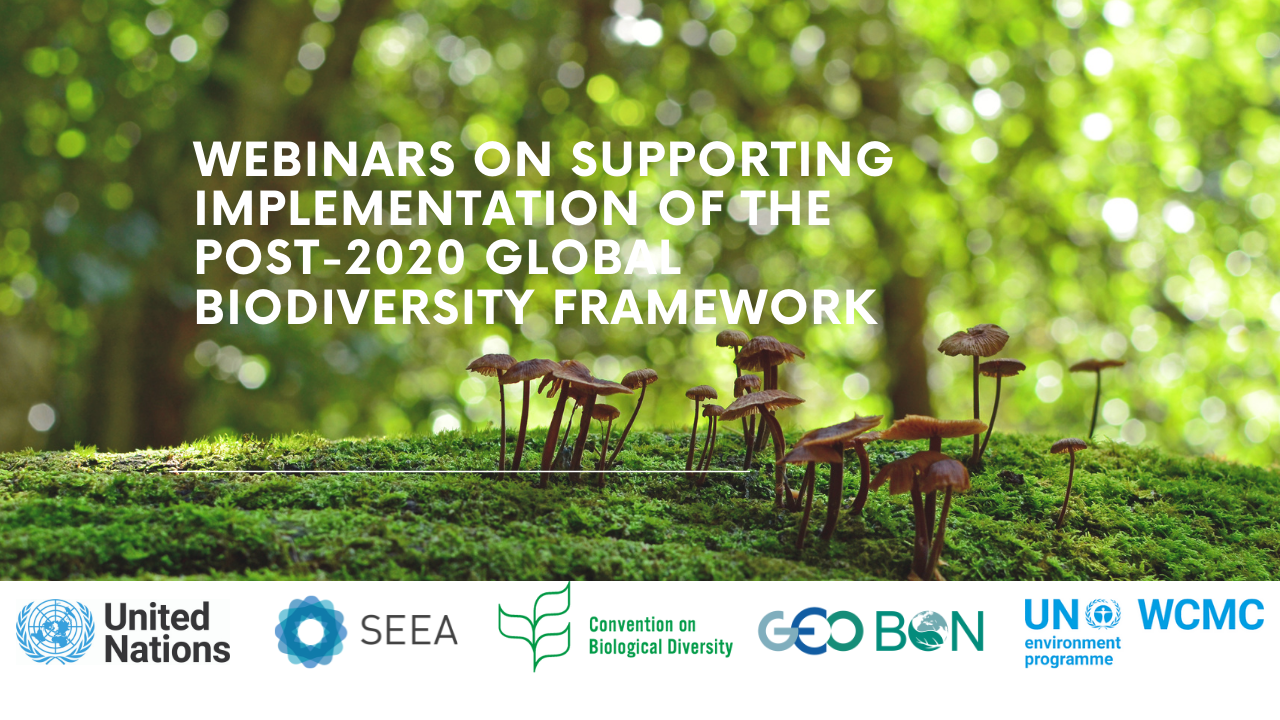
Webinars on Supporting Implementation of the Post-2020 Global Biodiversity Framework
The Secretariat of the Convention on Biological Diversity, the Group on Earth Observations Biodiversity Observation Network (GEO BON), the United Nations Statistics Division (UNSD) and United Nations Environment Programme World Conservation Monitoring Centre (UNEP-WCMC) in collaboration with the UN Regional Commissions have organized a series of webinars to increase the understanding of the monitoring framework of the post 2020 Global Biodiversity Framework (GBF), to foster collaboration between national statistical offices, Parties to the CBD and experts in the biological sciences for its operationalization and to discuss the current activities and technical aspects of implementation of the GBF monitoring framework at the global and national level.
Currently, the GBF monitoring framework is being developed for adoption at the Convention of Parties of the CBD. This will be a major enhancement in the review mechanism for the Convention as compared to the Aichi Framework in which indicators were not an official component of the framework. Analysis of the failure to achieve the Aichi Biodiversity Targets has identified a number of deficiencies. However, perhaps the most significant failing has been the lack of implementation support and enabling conditions at the national scale, particularly the implementation of data-to-indicator workflows that help streamline the monitoring of the impact of conservation actions in target achievements.
Parties to the CBD have struggled, in many cases, to easily and effectively track and guide progress to national targets due to their limited access to user-friendly indicator methodologies and the reliable data needed for these indicators. The current monitoring framework proposal for the GBF addresses some of these challenges by providing guidance so that Parties can easily identify appropriate indicators (i.e. Headline, Component and Detailed Indicators) for the different targets. However, further guidance will be needed for the sustained production, delivery and use of biodiversity indicators.
The adoption of the System of Environmental-Economic Accounting – Ecosystem Accounting (SEEA EA) at the 52nd Session of the UN Statistical Commission in March 2021 marks an important milestone for measuring ecosystem extent, condition and services in physical and monetary terms in a consistent manner. The SEEA EA allows to make the contribution of ecosystems to the economy and well-being explicit and for this reason it represents an historic step forward for measuring the Sustainable Development Goals and moving beyond GDP in tracking global progress. The contribution of the SEEA EA and the statistical community to the post-2020 GBF and mainstreaming biodiversity in the national statistical system have been recognized both by the statistical as well as the biodiversity community. According to the Global Assessment of Environmental Economic Accounting and supporting statistics undertaken by UNSD, 34 countries are implementing the SEEA EA and the demand for support in compiling these accounts is rapidly increasing. An implementation strategy to scale up the implementation of the SEEA EA will be submitted to the Statistical Commission in March 2022.
The GEO BON network, comprising over 200 organizations and over 1,700 experts on the delivery of effective biodiversity observations, has advanced in the conceptualization and operationalization of the Essential Biodiversity Variables (EBV), defined as a set of metrics capable of measuring state of species, populations, or ecosystems and used as a common basis for the calculation of indicators measuring biodiversity and ecosystem change. Furthermore, GEO BON has supported the establishment of 25 biodiversity observation networks (BONs) representing national, regional and thematic groups covering marine and terrestrial systems that coordinate biodiversity monitoring and supporting development of EBV, data use and sharing. GEO BON partners have been piloting the development of data to indicator workflows at the national scale (in SE Asia, Tropical Andes, Caribbean, Arctic and sub-Saharan Africa) that produce a repeatable and continuous approach to indicator development that integrates national data holdings with extra-national sources (e.g. remotely sensed data).
Considering the development of EBV, BONs and Biodiversity Change indicators endorsed by GEOBON, and recent adoption of the SEEA EA and their relevance to the GBF, this webinar series brought together relevant stakeholders from the CBD Parties, scientific communities and statistical communities to advance a shared understanding and have an initial discussion on implementing the GBF Monitoring Framework. The high-level regional webinars were conducted according to the official language or the region.
|
Region |
Language |
Date |
Time |
Chair |
|
Africa, Europe, North America and Caribbean |
English |
28 June |
9:00AM-10:30AM (EST) |
Anne Teller (EU) |
|
Asia Pacific |
English |
30 June |
9:00AM–10:30AM (GMT +7) |
Bhanumati (India) |
|
Latin America |
Spanish |
8 July |
11:00AM-12:30PM (EST) |
Rolando Ocampo (ECLAC) |
Registration
Documents
Video recordings
- High-level regional webinar on 28 June (Africa, Europe, North America and Caribbean)
- High-level regional webinar on 30 June (Asia-Pacific region)
- High-level regional webinar on 8 July (Lain America)
- Technical webinar on 12 July (Species populations and area based conservation)
- Technical webinar on 26 July (Genetic diversity)
- Technical webinar on 19 August (National Environmental-Economic Accounts of Ecosystem Services)
